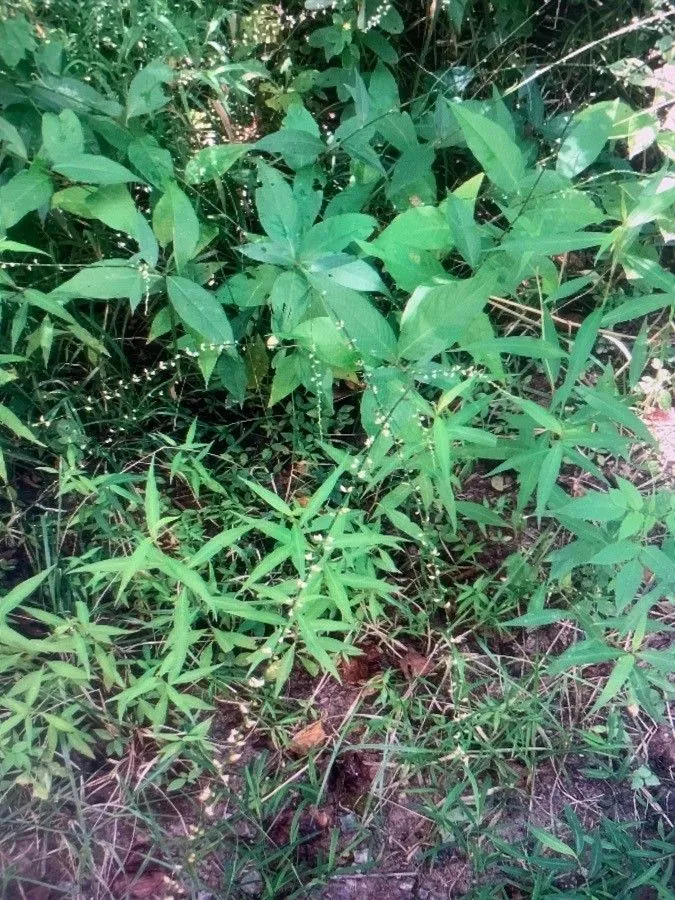
Author: (L.) Gaertn.
Bibliography: Fruct. Sem. Pl. 2: 180 (1790)
Year: 1790
Status: accepted
Rank: species
Genus: Persicaria
Vegetable: False
Observations: E. Canada to Mexico
Jumpseed, scientifically recognized as Persicaria virginiana, is a fascinating plant that is widely distributed from Eastern Canada down to the heart of Mexico. This species belongs to the Polygonaceae family and bears noteworthy historical significance with its formal classification dating back to 1790, as documented in “Fruct. Sem. Pl. 2: 180” by the distinguished botanist Gaertn.
Jumpseed thrives in a variety of habitats, ranging from lush woodlands to the edges of moist meadows, showcasing its remarkable adaptability. The plant has a recognizable form, characterized by its lance-shaped leaves that are adorned with unique red markings, a feature that adds visual interest to the natural landscape.
One of the most intriguing aspects of Jumpseed is its reproductive mechanism. The plant gets its common name from its ability to disperse seeds in a rather dramatic fashion. When touched, the seeds are forcefully ejected from the plant, allowing them to jump considerable distances from the parent plant. This fascinating seed dispersal method not only captures the curiosity of botanists and nature enthusiasts but also ensures a wider spread of the species in its natural habitats.
Persicaria virginiana plays a vital ecological role by providing food and habitat for various insects and small wildlife. The flowers, though modest in appearance, attract pollinators, including bees and butterflies, thus contributing to the biodiversity of the regions it inhabits.
In horticulture, Jumpseed can serve as a charming ground cover, especially for garden areas that mimic its natural woodland environment. Its resilience and the decorative appeal of its foliage make it a favorite among gardeners seeking to add a touch of the wild to their cultivated spaces.
Overall, Jumpseed (Persicaria virginiana) is a remarkable plant that not only stands out for its botanical characteristics but also enriches the ecosystems it calls home. It bridges the gap between the natural world and human appreciation, embodying both ecological significance and aesthetic value.
En: Jumpseed, Virginia knotweed, VIRGINIA SMARTWEED, American jumpseed
Eng: jumpseed, virginia knotweed, american jumpseed, virginia smartweed
Fra: renouée de virginie
Swe: trådpilört
Fi: Tähkätatar
Fr: Renouée de Virginie
Ht: Bab chat
Ko: 이삭여뀌
Fa: پرسیکاریا ویرجینیایی
Sv: Trådpilört
Taken Aug 23, 2021 by Richer Fortin (cc-by-sa)
Taken Sep 3, 2020 by Sasha Roper (cc-by-sa)
Taken Sep 10, 2022 by jeanne (cc-by-sa)
Taken Sep 2, 2022 by Barb T (cc-by-sa)
Taken Aug 17, 2021 by Shannon Ruthleigh (cc-by-sa)
Taken Sep 18, 2022 by Olivier Lhomme (cc-by-sa)
Taken Aug 14, 2021 by Pat Landeck (cc-by-sa)
Taken Aug 19, 2018 by karen (cc-by-sa)
Taken Aug 19, 2018 by karen (cc-by-sa)
Taken Aug 13, 2021 by yuriko yano (cc-by-sa)
Taken Aug 30, 2020 by kelsey cloonan (cc-by-sa)
Taken Aug 16, 2019 by Melissa Melissa Keneely (cc-by-sa)
Taken Aug 28, 2022 by Jeremy Disnard (cc-by-sa)
Taken Sep 2, 2022 by Barb T (cc-by-sa)
Taken May 31, 2022 by Garrett La Valley (cc-by-sa)
Taken Oct 14, 2019 by lauren davies (cc-by-sa)
Taken Sep 4, 2019 by Yung Dai (cc-by-sa)
Taken Sep 4, 2021 by Susanne Halfter (cc-by-sa)
Taken Apr 10, 2019 by Valrey Peebler (cc-by-sa)
Taken Jul 5, 2020 by Nafeesa Monroe (cc-by-sa)
Taken Sep 9, 2022 by Kai Best (cc-by-sa)
Taken Sep 4, 2021 by Andrea Bonnett (cc-by-sa)
Taken Aug 16, 2019 by Melissa Melissa Keneely (cc-by-sa)
Taken Aug 14, 2021 by Pat Landeck (cc-by-sa)
Taken Jun 12, 2021 by Maxime C (cc-by-sa)
Taken Oct 16, 2022 by Dieter Albrecht (cc-by-sa)
Taken Jul 28, 2021 by Dieter Albrecht (cc-by-sa)
Taken Oct 16, 2022 by Dieter Albrecht (cc-by-sa)
Taken Sep 25, 2021 by Pietro Brignoli (cc-by-sa)
Taken Sep 11, 2019 by Teena Cauffman (cc-by-sa)
Taken Sep 27, 2021 by Sarah Cornell (cc-by-sa)
Taken Sep 21, 2022 by c gore (cc-by-sa)
Taken Sep 3, 2021 by Don Sadowsky (cc-by-sa)
Taken Sep 20, 2022 by Anita M Schatz (cc-by-sa)
Taken Sep 6, 2020 by Stephen Talley (cc-by-sa)
Taken Oct 22, 2022 by Robin N (cc-by-sa)
Taken Oct 17, 2020 by angie g (cc-by-sa)
Taken Sep 5, 2021 by Lenore Roca (cc-by-sa)
Taken Jul 25, 2015 by EOL − Teage O’Connor (cc-by-nc)
Taken May 21, 2014 by EOL − David Yeany (cc-by-nc)
Taken Jul 26, 2004 by EOL − Steven J. Baskauf (cc-by-nc-sa)
Taken Jul 26, 2004 by EOL − Steven J. Baskauf (cc-by-nc-sa)
Taken Jul 6, 2021 by Robin N (cc-by-sa)
Taken Jul 28, 2021 by Dieter Albrecht (cc-by-sa)
© copyright of the Board of Trustees of the Royal Botanic Gardens, Kew.
Family: Myrtaceae Author: (F.Muell.) K.D.Hill & L.A.S.Johnson Bibliography: Telopea 6: 402 (1995) Year: 1995 Status:…
Family: Rubiaceae Author: Pierre ex A.Froehner Bibliography: Notizbl. Bot. Gart. Berlin-Dahlem 1: 237 (1897) Year:…
Family: Sapindaceae Author: Koidz. Bibliography: J. Coll. Sci. Imp. Univ. Tokyo 32(1): 38 (1911) Year:…
Family: Asteraceae Author: A.Gray Bibliography: Pacif. Railr. Rep.: 107 (1857) Year: 1857 Status: accepted Rank:…
Family: Fabaceae Author: Medik. Bibliography: Vorles. Churpfälz. Phys.-Ökon. Ges. 2: 398 (1787) Year: 1787 Status:…
Family: Aspleniaceae Author: (Cav.) Alston Bibliography: Bull. Misc. Inform. Kew 1932: 309 (1932) Year: 1932…